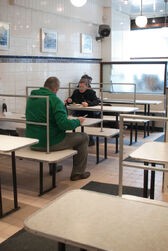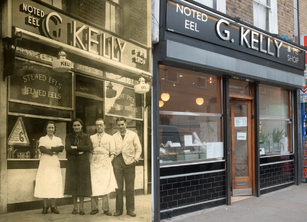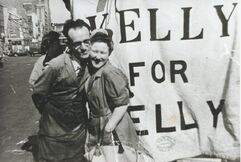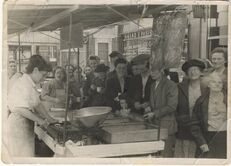G. Kelly is the name of two Pie & Mash shops, situated in the East End of London. Frequented by The Krays and The Firm notably, Albert Donoghue when he was a young man, the shops are still trading today and form a rich part of the East End's heritrage.
History
414 Bethnal Green Road
In 1915 Samuel Robert Kelly opened a shop in Bethnal Green. He had been working as a tram driver but an injury forced him to give up this work. He decided to invest some compensation money he had received into a business and opened his first Eel and Pie shop in Bethnal Green Road. He and his wife Matilda had four children Samuel, George, Matilda and Joe who all went on to open eel and pie shops.

Interior of the Roman Road shop, notice the virtually unchanged interior.
George, however, was the most entrepreneurial, running a successful eel supply business as well as the eel and pie shops. In 1930 he married local beauty Theresa Kingdon and she began to assist him in the business. George opened shops in Bethnal Green Road, Broadway market and Roman Road market. He also persuaded Theresa’s parents to open a pie shop and they purchased an existing pie shop owned by Mr Holloway on the 4th August 1939. This was at 310 Roman Road (now re-numbered 600).
526 Roman Road
The Roman Road shop was founded in 1939 by George Kelly, lending the shop its name. However, the shop has remained a Pie & Mash shop since the early 1920’s. In the mid 1950s the shop was bought by Bill Kingdon, George’s brother in law. Today, the shop is run by Sue, Bill’s daughter, and family.

George Kelly opening the shop in 1939, compared to today. George Kelly opened the shop in 1939. By the mid 1950’s the shop had been bought by George’s brother in-law, Bill Kingdon. Bill’s daughter, Sue, owns the shop today.
The Second World War was imminent and rationing threatened to halt supplies of meat to the pie shops. Theresa’s brother Bill Kingdon set about persuading the Ministry of Food to allow a quota which then enabled the shops to stay open for business. Many East Enders were very grateful that there was pie and mash to supplement their rations and provide a hot meal after a night in the shelters! Although Bill went into the army during the war his wife Bea joined the family firm and started to work in the pie shops. By the mid-fifties Bill had purchased the business from his sister Theresa Kelly and brother-in-law George. This broke any trading links with any other Kelly’s. He carefully nurtured the trade and his high standards of quality and cleanliness have contributed to the shop’s excellent reputation. Sadly he died in 1969 but his widow Bea took over, and with her earlier experience the business continued to flourish.
In 1972 Bea and her daughter Susan had the opportunity to take-over the shop at 600 Roman Road. 526 and 600 Roman Road were then run in conjunction for thirty-seven years until 2009 when 600 finally closed. Bea retired in 1995 but Bill and Bea’s daughter Susan took over, now Susan runs the business in partnership with her son Neil.
History of Pies & Jellied Eels
Before the arrival of Eel and Pie shops, pies were sold by itinerant pie-men and eels by street sellers of pea soup and hot eels. The first pie shops were seen in London in the middle of the nineteenth century.

A Kelly’s eel stall ca. 1940 featuring the slogan “Kelly for Jelly”, referencing the sale of jellied eels. Before the opening of pie shops, eel stalls were the main outlets selling cooked eels.
In 1851 Henry Mayhew, a social historian, studied the occupations of London’s poor, published as ‘London Labour and the London Poor’. It is a classic account of London’s street life and characters. His fascinating descriptions shed light on life around the streets of Victorian London and here he writes about the ‘street pie men’ and ‘the street-sellers of pea-soup and hot eels’. Pie men travelled the streets, visiting taverns, summer fairs and the races. It was common practice to toss a penny for the pie; if the pie man won the toss he received the penny and handed nothing over, but if the customer won he would keep both pie and penny. The sellers of hot eels sold from stalls in the streets. Eels were purchased from Billingsgate having been brought up the Thames by Dutch eel vessels. According to Mayhew around five hundred sellers of eels could be seen on the streets on a Saturday. The most successful trader dealt in Clare market which was near the Strand. ‘The price of hot eels was a halfpenny for five or seven pieces of fish and three-parts of a cupful of liquor’.Around the middle of the nineteenth century the street sellers came under threat from newly opening pie shops. Mayhew writes ‘a few years ago the street pie trade was very profitable, but it has been almost destroyed by the pie shops. The penny pie shops, the street men say, have done their trade a great deal of harm. These shops have now got mostly all the custom, as they make the pies much larger for the money than those sold in the street.’

A queue forms at a Kell’s eel stall ca. 1940.
Victorian London saw a huge growth in population: a movement of poor and agricultural workers from rural areas, Irish immigrants fleeing the great famine and refugees from political and religious persecution in Europe. These were poor families living in appalling slum conditions and probably with no access to cooking facilities. The new pie shops selling the combination of pie and mash and eels in liquor provided hot food cheaply and business flourished.
By 1874 the business directory ‘Kelly’s’ listed thirty-three eel and pie shop.
